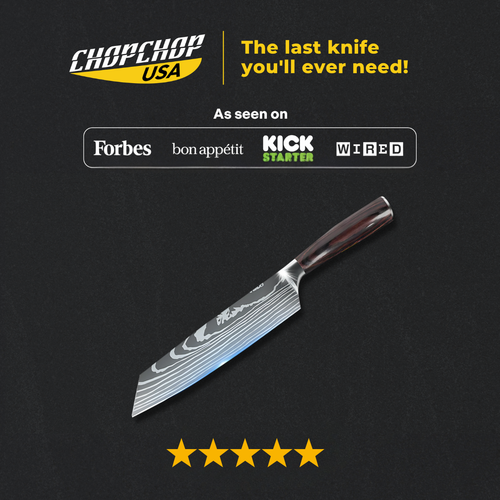How to cook eggs on stainless steel? The key is heating the pan properly and using enough fat to prevent sticking. While it takes a little practice, once mastered, cooking eggs in stainless steel delivers excellent results without chemical coatings. In this guide, ChopChop USA will show you why stainless steel is a great choice for eggs, step-by-step instructions, and how to avoid common mistakes—so you can enjoy perfect eggs every time.
Why Choose Stainless Steel for Cooking Eggs?

Is Stainless Steel Cookware Safe? Many home cooks wonder why anyone would choose stainless steel over a non-stick surface for eggs. The answer lies in safety, durability, and superior cooking performance. Once you understand how to cook eggs on stainless steel, you’ll appreciate the results and the lack of synthetic coatings.
Here’s why stainless steel is a smart choice:
- Healthier cooking – No chemical coatings, making it a safe, non-toxic choice.
- Long-lasting durability – Stainless steel doesn’t chip or peel like non-stick pans.
- Better browning and control – Mastering how to cook eggs on stainless steel gives you crisp edges and fluffy centers.
- Oven and induction ready – Versatile for multiple cooking methods.
How to Cook Eggs on Stainless Steel – Step by Step

Once you know the basics, how to cook eggs on stainless steel becomes second nature. Here’s a foolproof step-by-step guide:
Step 1: Preheat the Pan
Stainless steel pans need to be preheated. Set your burner to medium and wait 2–3 minutes. Use the water drop test: flick a few drops of water onto the surface—if they dance and sizzle, the pan is ready. Preheating ensures your eggs won’t stick.
Step 2: Add Enough Fat
Once hot, add 1–2 teaspoons of oil or a small pat of butter. Tilt the pan to coat the surface evenly. The fat acts as a barrier between the eggs and the metal.
Step 3: Crack the Eggs
Room-temperature eggs work best when learning how to cook eggs on stainless steel. Cold eggs can cool the pan down too quickly and lead to sticking. Crack eggs into a bowl first to avoid shell fragments, then pour gently into the pan.
Step 4: Control the Heat
Keep your heat at medium to medium-low. Eggs cook fast, and too much heat can scorch them or make them stick. Allow the eggs to cook undisturbed for a minute or two.
Step 5: Flip or Stir Gently
Once the edges lift naturally with a silicone spatula, you can flip, stir, or fold the eggs depending on the style. If your eggs are still stuck, give them another few seconds—they’ll release on their own when ready.
How to Cook Different Egg Styles
Once you’ve learned the basics of how to cook eggs on stainless steel, you can start exploring different egg styles. Here’s how to cook the most popular types of eggs using a stainless steel pan:
Scrambled Eggs

Scrambled eggs are a great starting point when learning how to cook eggs on stainless steel. Begin by whisking your eggs thoroughly with a splash of milk, cream, or even water for fluffiness.
Once your stainless steel pan is preheated and greased, pour in the eggs and let them sit for a few seconds to set. Stir gently with a silicone spatula, folding the eggs from the edges toward the center. Cook until they’re softly set, then remove them from the heat—they’ll finish cooking from residual heat in the pan.
Sunny Side Up Eggs

If you love runny yolks, sunny side up is the way to go. To master this style on stainless steel, preheat your pan and coat it generously with oil or butter. Crack the egg gently into the pan and reduce the heat to low.
Let it cook slowly without flipping, allowing the whites to fully set while the yolk remains bright and soft. One of the secrets of how to cook eggs on stainless steel sunny side up is to cover the pan briefly with a lid to help the tops cook evenly.
Over-Easy Eggs

Over-easy eggs are similar to sunny side up, but they’re flipped once to lightly cook the yolk’s surface. Start just as you would with sunny side up—preheat the pan, add fat, and crack in the egg.
Once the whites are fully set and can lift easily with a spatula, gently flip the egg and cook for 15–30 seconds more. Be careful not to break the yolk during the flip.
Over-Hard Eggs

For firmer yolks, try over-hard eggs. This method starts like over-easy, but after flipping the egg, you let it cook longer—up to 1–2 minutes—until the yolk is fully set. If you like your eggs well-done with no runniness, this is a great style to learn.
Just be sure to monitor the heat so the whites don’t get too crispy or rubbery.
Poached Eggs (Pan-Steam Method)

Though traditionally made in water, poached eggs can be made using a clever pan-steaming trick. To try this method on stainless steel, heat the pan, grease it, and crack in the egg. Add a tablespoon of water to the pan and immediately cover it with a lid to trap steam.
Cook for 1–2 minutes until the whites are set and the yolk is still runny. It’s an alternative way to practice how to cook eggs on stainless steel with a soft, poached texture—without using a pot of water.
Omelets

Omelets allow you to get creative with fillings and flavors. Whisk the eggs and pour them into a well-oiled, hot stainless steel pan. Let them cook undisturbed for 30–60 seconds until the bottom sets, then gently lift the edges while tilting the pan to allow uncooked egg to flow underneath.
Add fillings like cheese, herbs, or vegetables before folding the omelet in half. Once you’ve grasped how to cook eggs on stainless steel, omelets become a quick and satisfying meal any time of day.
Common Mistakes to Avoid
Even with the best pans, eggs can stick if common mistakes aren’t avoided. As you learn how to cook eggs on stainless steel, here’s what not to do:
- Skipping the preheat step – Always heat the pan before adding oil or eggs.
- Not using enough fat – A dry surface guarantees sticking.
- Using cold eggs – Can cause sticking and uneven cooking.
- Cooking on too high heat – Causes browning before the eggs are set.
- Using metal utensils – Can damage the surface or cause scratching.
Troubleshooting Common Issues
Even after learning the basics of how to cook eggs on stainless steel, you may run into a few common problems—like sticking, uneven cooking, or overcooked yolks. Don’t worry! Most of these issues are easy to fix with a few small adjustments to your technique or heat control.
Eggs Stick to the Pan
One of the most frequent complaints when learning how to cook eggs on stainless steel is that the eggs stick to the surface. This usually happens when the pan isn’t hot enough or hasn’t been properly greased. Stainless steel doesn’t have a natural non-stick coating, so you need to rely on heat and oil to create that effect. To prevent sticking:
- Always preheat the pan for 1–2 minutes on medium heat.
- Add enough fat (butter or oil) and allow it to shimmer or foam slightly.
- Test the heat by adding a drop of water—if it dances, the pan is ready.
If eggs still stick, try reducing your heat slightly and adding a bit more oil.
Whites Cook Too Fast, Yolks Stay Raw
This can happen if your pan is too hot when you add the eggs. Stainless steel retains heat well, so once it’s hot, it can continue to cook the egg from the bottom too aggressively. To solve this:
- Lower the heat once you’ve added the eggs.
- Cover the pan briefly to allow gentle top-side cooking from the trapped steam.
- Try cracking the eggs into a small bowl first, then gently sliding them into the pan to minimize spreading and promote even cooking.
Egg Whites Are Rubbery or Overcooked
Rubbery whites usually mean the eggs have cooked too long or at too high a temperature. This is a common pitfall, especially when scrambling or making over-hard eggs. For better results:
- Cook over medium or medium-low heat.
- Remove the eggs from the pan just before they’re fully set—they’ll continue cooking slightly from residual heat.
- Avoid constantly stirring scrambled eggs; let them gently set, then fold.
Eggs Are Unevenly Cooked
Uneven cooking often comes from cold spots on the pan or poor heat distribution. If one side of your eggs is burnt while the other is undercooked, try this:
- Make sure your pan is fully preheated before adding eggs.
- Use a high-quality stainless steel pan with an encapsulated base, like the ChopChop USA Stainless Steel Frying Pan, which distributes heat evenly.
- Don’t overcrowd the pan—give your eggs room to spread and cook uniformly.
Residue or Browning Left in the Pan
A brown or crusty residue left behind isn’t just hard to clean—it can also affect the taste of your eggs. This often happens when oil burns or eggs cook too long in one spot. To fix it:
- Use enough fat to coat the pan evenly.
- Keep heat at a moderate level to avoid burning oil.
- Gently lift or flip eggs rather than dragging them across the pan.
You may want to read How to Clean Stainless Steel Pans So They Last For Years?
Upgrade Your Egg Game with ChopChop USA’s Stainless Steel Pan

When it comes to mastering how to cook eggs on stainless steel, the quality of your pan can make all the difference. A well-made stainless steel pan doesn’t just improve cooking—it transforms your experience in the kitchen. That’s where the ChopChop USA Stainless Steel Frying Pan comes in. Built for everyday use, this pan combines professional-grade performance with user-friendly features that make cooking eggs (and just about anything else) easier, cleaner, and more consistent.
Whether you’re frying, scrambling, poaching, or flipping, this pan gives you the control and durability you need to get perfect results every time. The ChopChop USA Pan is also highly-rated as one of the Best Stainless Steel Skillets 2025.
Why Choose ChopChop USA’s Stainless Steel Frying Pan?
- Food-safe stainless steel
- No toxic coatings
- Oven- and induction-ready
- Comfortable, stay-cool handle
- Easy to clean and maintain
Conclusion
Mastering how to cook eggs on stainless steel is a valuable skill that opens up healthier, tastier, and more professional-style cooking at home. With the right temperature, a little oil, and a quality stainless steel pan, your eggs will slide right off and taste delicious.
If you're serious about learning how to cook eggs on stainless steel, don’t settle for cheap cookware. Choose the pan designed for performance and durability—ChopChop USA’s Stainless Steel Frying Pan—trusted by everyday cooks and chefs alike.
For more amazing recipes, follow us on Facebook and Instagram! If you have any questions about ChopChop USA's products or promotions, please feel free to contact us at support@chopchopusa.com. Our dedicated team is available 24/7 and always happy to assist you.
Frequently Asked Questions
1. Do I always need to preheat my stainless steel pan before cooking eggs?
Yes. Preheating is essential in learning how to cook eggs on stainless steel without sticking.
2. What kind of oil is best for stainless steel?
Use butter, ghee, avocado oil, or olive oil—anything with a medium to high smoke point.
3. Why do my eggs keep sticking?
The most common reasons are: pan wasn’t hot enough, not enough oil, or too much heat after adding eggs.
4. Is stainless steel safe for everyday egg cooking?
Absolutely. It’s one of the safest and most durable options.
5. Can I use ChopChop USA’s stainless steel pan for other foods too?
Yes! It’s perfect for everything from eggs to meats, veggies, and sauces—making it a versatile kitchen essential.
6. Can I Put Stainless Steel in the Dishwasher?
Yes—but with a few important considerations. While most stainless steel kitchenware is dishwasher safe, certain conditions and types of items may require handwashing instead.




